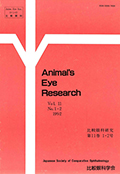Volume 11, Issue 1-2
Displaying 1-8 of 8 articles from this issue
- |<
- <
- 1
- >
- >|
Lecture and Reports at 11th Annual Meeting of Japanese Society of Comparative Ophthalmology
Special Lecture
-
1992 Volume 11 Issue 1-2 Pages 1-2_1-1-2_19
Published: 1992
Released on J-STAGE: December 25, 2020
Download PDF (5230K)
Reports
-
1992 Volume 11 Issue 1-2 Pages 1-2_21-1-2_31
Published: 1992
Released on J-STAGE: December 25, 2020
Download PDF (2979K) -
1992 Volume 11 Issue 1-2 Pages 1-2_33-1-2_36
Published: 1992
Released on J-STAGE: December 25, 2020
Download PDF (1397K) -
1992 Volume 11 Issue 1-2 Pages 1-2_37-1-2_41
Published: 1992
Released on J-STAGE: December 25, 2020
Download PDF (1579K) -
1992 Volume 11 Issue 1-2 Pages 1-2_43-1-2_45
Published: 1992
Released on J-STAGE: December 25, 2020
Download PDF (988K)
Poster Session
-
1992 Volume 11 Issue 1-2 Pages 1-2_47-1-2_49
Published: 1992
Released on J-STAGE: December 25, 2020
Download PDF (864K) -
1992 Volume 11 Issue 1-2 Pages 1-2_51-1-2_56
Published: 1992
Released on J-STAGE: December 25, 2020
Download PDF (1294K)
Information & Data
-
1992 Volume 11 Issue 1-2 Pages 1-2_57-1-2_62
Published: 1992
Released on J-STAGE: December 25, 2020
Download PDF (1714K)
- |<
- <
- 1
- >
- >|
